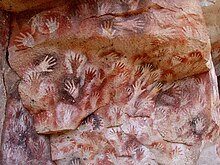A stencil is a thin sheet of material, such as paper, plastic, or metal, with letters or a design cut from it, used to produce the letters or design on an underlying surface by applying pigment through the cut-out holes in the material. The key advantage of a stencil is that it can be reused to repeatedly and rapidly produce the same letters or design. The design produced with a stencil is also called a stencil. The context in which stencil is used makes clear which meaning is intended. Although aerosol or painting stencils can be made for one-time use, typically they are made to be reusable. To be reusable, they must remain intact after a design is produced and the stencil is removed from the work surface. With some designs, this is done by connecting stencil islands (sections of material that are inside cut-out "holes" in the stencil) to other parts of the stencil with bridges (narrow sections of material that are not cut out).
Stencil technique in visual art is also referred to as pochoir. A related technique (which has found applicability in some surrealist compositions) is aerography, in which spray-painting is done around a three-dimensional object to create a negative of the object instead of a positive of a stencil design. This technique was used in cave paintings dating to 10,000 BC, where human hands were used in painting hand print outlines among paintings of animals and other objects. The artist sprayed pigment around his hand by using a hollow bone, blown by mouth to direct a stream of pigment.
Screen printing also uses a stencil process, as does mimeography. The masters from which mimeographed pages are printed are often called "stencils." Stencils can be made with one or many colour layers using different techniques, with most stencils designed to be applied as solid colours. During screen printing and mimeography the images for stenciling are broken down into color layers. Multiple layers of stencils are used on the same surface to produce multi-colored images.
sumber wikipedia
Stencil technique in visual art is also referred to as pochoir. A related technique (which has found applicability in some surrealist compositions) is aerography, in which spray-painting is done around a three-dimensional object to create a negative of the object instead of a positive of a stencil design. This technique was used in cave paintings dating to 10,000 BC, where human hands were used in painting hand print outlines among paintings of animals and other objects. The artist sprayed pigment around his hand by using a hollow bone, blown by mouth to direct a stream of pigment.
Screen printing also uses a stencil process, as does mimeography. The masters from which mimeographed pages are printed are often called "stencils." Stencils can be made with one or many colour layers using different techniques, with most stencils designed to be applied as solid colours. During screen printing and mimeography the images for stenciling are broken down into color layers. Multiple layers of stencils are used on the same surface to produce multi-colored images.
History
Stencil paintings of hands were common throughout the prehistoric period. Stencils may have been used to colour cloth for a very long time; the technique probably reached its peak of sophistication in Katazome and other techniques used on silks for clothes during the Edo period in Japan. In Europe, from about 1450 they were commonly used to colour old master prints printed in black and white, usually woodcuts.This was especially the case with playing-cards, which continued to be coloured by stencil long after most other subjects for prints were left in black and white. Stencils were used for mass publications, as the type didn't have to be hand-written.sumber wikipedia










0 komentar:
Post a Comment